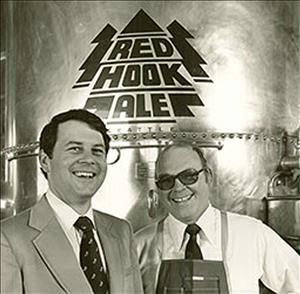On August 11, 1982, a new and exciting type of beer has its official debut at Jake O'Shaughnessy's, a popular Seattle restaurant and bar. It will prove to be a pivotal event, helping to launch a craft-beer movement throughout Washington and marking an important chapter in local brewing history.
A New Brewery for a New Beer
This story begins in 1981 when Gordon Bowker set out with a goal of "brewing Seattle a better beer." In the early 1970s, Bowker had revolutionized the coffee industry when he cofounded Starbucks, and he would now attempt to do the same in the beer world. Joining him in the endeavor was local advertising ace, Paul Shipman, who served as the new company's president. At the time, the American market was saturated with bland, commercial lagers, and the two men wanted to introduce a high-quality beer that was more similar to a European-style ale. As Shipman explained to local newspapers, "We believe there is a strong demand in Seattle for a locally produced ale brewed to the same quality standards as the finest imported products" ("Brewers Find Beer-Barrel Polka …").
Bowker and Shipman's next task was finding the right person to make them a quality beer. They recruited a veteran brewmaster, Charlie McElevey, who had learned his craft at Germany's top brewing school before running things at Seattle's Rainier Brewery. They set up shop inside a former transmission shop in Seattle's Ballard neighborhood, transforming the space into a 5,000-square-foot brewery equipped with antique copper kettles purchased from a brewery in West Germany. The named it Redhook Brewery, and it was incorporated as a business in May of 1981. Theirs would be the first new Seattle brewery to open in more than 40 years.
On June 13, 1982, an article in The Seattle Times announced that Redhook was about to begin brewing its first beer. After careful consideration, the team had decided to take inspiration from a spicy Belgian ale recipe, and McElevey went right to work, brewing several different batches before finally deciding on one that would serve as their inaugural beer. McElevey was under a tremendous pressure and facing a strict deadline. Local restaurateur Mick McHugh -- a friend of Bowker's going back to when they were youthful guides for the Seattle Underground Tour -- had an upcoming soiree at his popular drinking and dining establishment, Jake O'Shaughnessy's. He had invited Redhook to the event, giving it an opportunity to showcase its new beer. Washington Governor John Spellman (1926-2018) and Seattle Mayor Charles Royer (b. 1939) were both scheduled to be in attendance that night, so the stakes were high.
McElevey's training and experience as a brewmaster paid off. Despite the strict deadline, he had their inaugural beer -- which was named simply Redhook Ale -- ready in time for the big event. That night at O'Shaughnessy's, at the specified time, Bowker and Shipman rolled out their first keg of Redhook Ale in a wheelbarrow to a very excited crowd. The keg was tapped and the first glasses of the beer were poured. For many in attendance, their previous experience with beer had been limited to the commercial brands available at the neighborhood grocery store, and Redhook Ale was a new and different kind of brew.
Mixed Reviews, Better Brews
The initial reception to the new beer was mixed, with some becoming instant converts, while others disliked its fruity pungency. A few local bars agreed to carry this first batch of Redhook Ale, but its quirky flavor soon earned it the nickname "banana beer." The taste problem was eventually traced to an infected yeast strain, which the brewery quickly rectified. "Where we made our mistake was trying to get the product out too quickly," Bowker later explained. "We wanted to be ready for Jake O'Shaughnessy's" ("The Man Who Made Seattle …")
The brewery quickly changed gears, using a new strain of yeast to develop a cleaner-tasting series of ales. It was a learning experience for owners and brewmaster, and they used the missteps to set themselves up for great success. "We made mistakes along the way," admits Bowker. "But if we hadn't made those mistakes, other people wouldn't have been able to do it. We were reinventing the wheel" ("Here's to Washington's …"). Redhook Ale was replaced with Extra Special Bitter (or simply, ESB), which received a much better reception and soon became one of the brewery's most popular offerings. Other inventive beers were introduced to much fanfare, including Ballard Bitter, Blackhook Porter, and Long Hammer IPA. Before long, Redhook's line of beers became immensely popular in bars and taverns across the state, thus cementing Seattle's role in the craft-beer revolution.
Looking back at Redhook's early days, Shipman would later recall, "We inspired people to become microbrewers, because every home brewer who tasted our beer thought they could make better beer in their bathtub … If Redhook could be this successful with a beer that tasted this odd, just think what they could do with a good-tasting beer" ("Redhook: A Microbrew Success Story").

